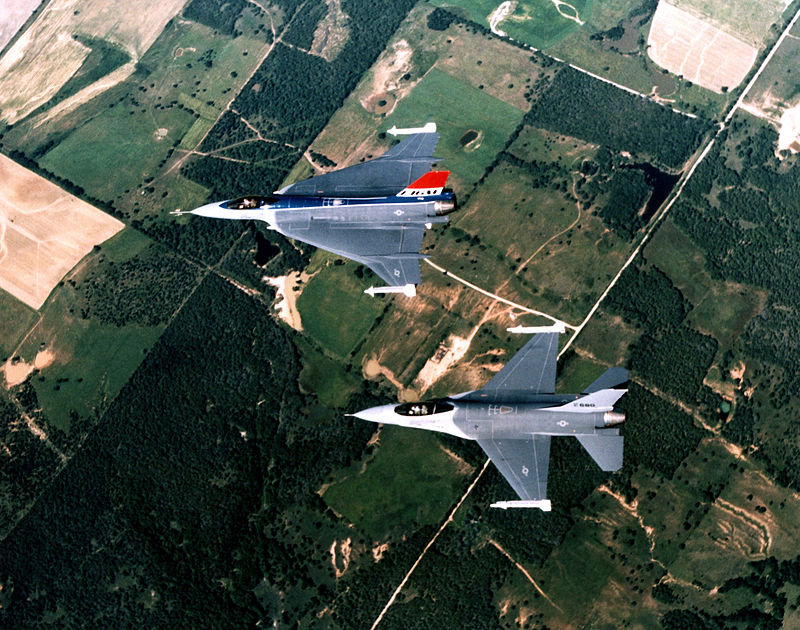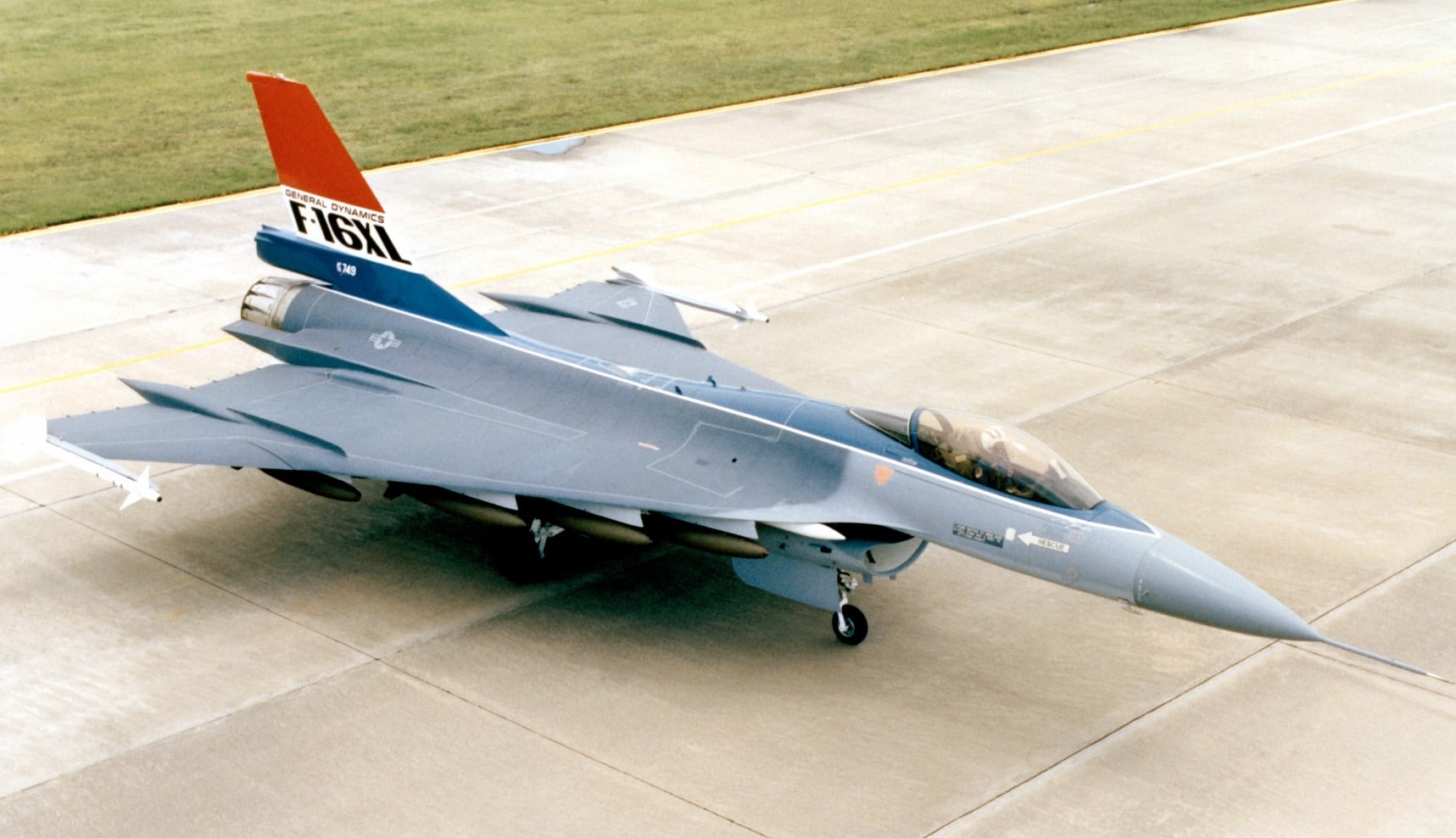- Yes
- No
Although it ultimately lost against the F-15E Strike Eagle, the two planes that makes up the F-16XL variant are real enough to potentially live again in the skies of War Thunder.

History
Spoiler
With YF-16 winning the Lightweight Fighter Program, General Dynamics quickly looked onwards and began working on derivatives of the F-16 to further improve the airframe. Led by Harry J. Hillaker - the deputy chief engineer of the YF-16 - the project partook in the Supersonic Cruise And Maneuvering Program (SCAMP) with the goal of producing an aircraft capable of Supercruising, or the ability to maintain supersonic flight without the assistance of afterburners. To achieve this, the team experimented with various wing configurations in collaboration with NASA Langley Research Center before settling on a “Cranked-Arrow” delta wing, which proved to offer more than twice the wing area with minimal difference in drag.
Impressed by this development, the USAF provided two F-16 airframes to Hillaker to be heavily modified into the full-size prototype of the SCAMP concept. Now dubbed F-16XL, the craft gained an additional 56 inches from the extra sections added to the front and back and the second prototype became a two-seater after a mishap during construction, but the large, new, carbon fiber-skinned wing undoubtedly drew attention. Not only could it hold 82% more fuel, it also boasts 17 hardpoints (or 27 according to some sources), twice the amount of the F-16A at the time. Furthermore, it can achieve up to eighty-three knots over its production counterpart at sea level at military power setting and 311 knots on afterburner at altitude while carrying a bomb load.
The reception of the plane was high, as F. Clifton Berry Jr. - the editor-in-chief of Air Force magazine at the time - would say in 1983, “To say that Hillaker’s design team achieved its objectives is an understatement.” So it was no surprise that the Air Force would submit the design to the Enhanced Tactical Fighter (ETF) competition (later, Dual-Role fighter program) to determine the replacement of the F-111 Aardvark. There it would face competition from another modified form of an existing aircraft: the F-15E Strike Eagle.
Unfortunately for the F-16XL, the F-15E has several leg-ups on its delta-winged rival. Sharing many parts with the production F-15D allows for a cheaper production cost compared to the largely new construction of the XL, and the existence of the second engine may mean life or death in the mission deep within enemy airspace - the primary goal of ETF competition. These factors, plus higher top speed and service ceiling, ultimately meant defeat for the F-16 variant.
All was not lost for the two prototypes, however, as the two would live the rest of their active life as NASA’s research crafts to perform various aeronautical experiments before retiring to the Air Force Flight Center Museum.
Specifications
Spoiler
For clarification, “75-0749” will be referred to XL#1 and “75-0747” as XL#2
Length: 54 ft 2 in (16.51m)
Wingspan: 32 ft 5 in (9.88 m) (34 ft 3 in/10.44m measurement listed in some sources includes the AIM-9 at wingtip)
Height: 17 ft 7 in (5.36m)
Wing Area: 633 square ft (58.8 square m) (A source lists this as 663 square ft, I believe this is a typo.)
Empty Weight: around 22,000 pounds
Maximum Take-Off Weight: around 48,000 pounds
Take-Off Roll: Estimated to be 3,000 ft (914.4 m)
Maximum Speed at 40,000 ft:
- Mach 1.8 (1,260 mph / 2027.77 km/h) for XL#1
- Mach 2 (1,400 mph / 2253.08 km/h) for XL#2
Service Ceiling: 50,000 ft (15.24 km)
Powerplant:
- Pratt & Whitney F100-PW-200 turbofan for XL#1 (12,240 lbf dry and 23,830 lbf with afterburner)
- General Electric F110-GE-129 turbofan for XL#2 ( 17,155 lbf dry and 28,984 lbf with afterburner)
Crew:
- 1 for XL#1
- 2 for XL#2
Armament:
- 1 × 20 mm M61 Vulcan rotary cannon
- 17 hardpoints (Some sources suggest 27 in the following layout: 16 wing weapons stations, 4 semi-submerged AIM-120 stations, 2 wingtip stations, 1 centerline station, 2 wing “heavy / wet” stations, 2 chin stations for LANTIRN)
-
- AIM-9 Sidewinder
-
- Mk 82 500-pound General-Purpose Bombs
-
- AIM-120 AMRAAM Missiles

- AIM-120 AMRAAM Missiles
More Pictures
Spoiler
Evidence that it has more than 17 hardpoints. It’s carrying 2 AIM-9 Sidewinders on the wingtip stations, two underwing 370 gal fuel tanks, 10 Mk.82 (500lbs) General Purpose bombs on underwing stations, 2 Mk.82s on the centerline, and 4 semi-recessed AIM-120 AMRAAAMs.





Sources
Primary Source
- The Revolutionary Evolution of the F-16XL | Air & Space Forces Magazine
- Elegance in Flight: A comprehensive History of the F-16XL Experimental Prototype and its Role in NASA Flight Research - NASA
Secondary Sources
- https://www.wearethemighty.com/mighty-tactical/f-16xl-27-weapons/
- The F-16XL: This Advanced F-16 Variant Lost Out To The F-15E Strike Eagle, But Was It Better?
- F-16.net - The ultimate F-16, F-35 and F-22 reference
- F-16XL - The Crank Wing Experiment - PlaneHistoria
- F-16XL Fighter Was Never Allowed to Fly for the U.S. Air Force | The National Interest







